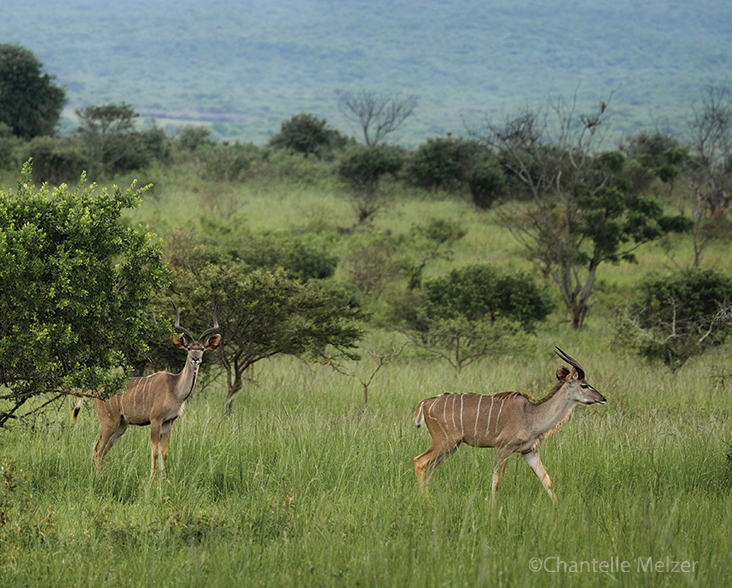Greater Kudu
Species Data
Class: Mammalia
Order: Artiodactyla
Family: Bovidae
Scientific Name: Tragelaphus strepsiceros
IUCN Red List status:Least Concern
Description
A large and beautifully patterned antelope, the Greater Kudu reaches 1.4-1.55 m tall at the shoulder, with bulls weighing up to 250 kg and the smaller cows reaching 165 kg. The fur is grey-brown to rufous, bulls typically being greyer, with 6-10 vertical white stripes on the sides and a dark line on the belly. The face has a distinct white line between each eye, with white blotches on the cheeks and a white mouth. The large ears are pinkish on the inner surface, edged black and white with long white fur at the base. The 43 cm long brown or blackish bushy tail is white below with a black tip. Bulls have a short mane running down the neck and behind the shoulders and fringes of much longer black, brown and white hair on the underside of the neck and throat. Only bulls have the distinctive 120 cm spiral horns.
Behaviour
This secretive species is most active in the early morning or late afternoon, although they are nocturnal in habit in the areas where they are hunted. Greater Kudus are herbivorous, mainly browsing on leaves, herbs, fruits, vines, and flowers, but also occasionally graze on grass and, in some areas, will eat crops such as maize and vegetables, receiving enough moisture from their diet to survive for long periods without water, and only needing to drink when vegetation is dry.
Greater Kudus stay close to the shade of trees on hot days and on cold days remain within thickets. Non-migratory and non-territorial, this species has a home range of 90-350 ha (222-865 acres) that may increase to 600 ha (1,483 acres) during periods of drought.
Bulls are solitary or form small bachelor groups of similarly aged individuals. Mature bulls around 5-8 years of age form herds of 2-4 individuals, while immature bulls 2-5 years of age and post-mature bulls over eight years old form separate groups numbering 2-6 individuals. During the rutting period, 1-2 mature bulls will leave their group for short periods to join a female herd comprising 2-4 adult cows and their young and form a family breeding group. Family bonds are weak, with individuals readily moving between neighbouring family groups.
Calves are born throughout the year; however, most births are between December and March. After a gestation period of 8.5-9 months, cows leave the herd to give birth to a single calf weighing around 16 kg, leaving it hidden in long grass and returning to suckle 2-4 times a day for two weeks, after which time the calf joins the herd. Calves are weaned at six months.


Behaviour
The Greater Kudu inhabits broken bushveld, mixed scrub woodland, wooded savannah with 50-80% tree cover, and regenerating abandoned fields and degraded pastures with good cover, with a preference for acacia woodland and mopane bush on lowlands, rocky hills, and mountains up to 2,400 m.
This species occurs in Chad, Sudan, South Sudan, and Central African Republic in central Africa, and in East Africa from Eritrea and Ethiopia south to southern Africa and as far west as Angola and Namibia.
Threats and Conservation
This species has disappeared from much of the northern part of its range due to overhunting and habitat loss, in contrast to Tanzania, central, and southern Africa where populations are either stable or increasing, and this species remains abundant due to its ability to survive in settled areas, with the largest numbers in Namibia and South Africa. The Greater Kudu is heavily hunted in southern Africa for its high-quality meat, and bulls are targeted by trophy hunters for their horns. Along with overhunting, habitat loss is a threat to this species in parts of its range. Overall, the global population is estimated at 300,000-350,000 mature individuals and is considered stable; therefore, the Greater Kudu is listed as Near Threatened on the IUCN Red List.
